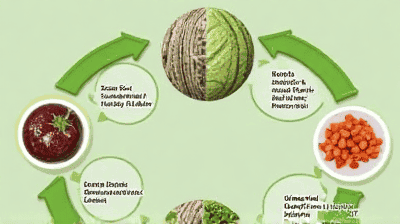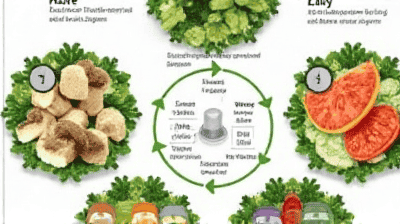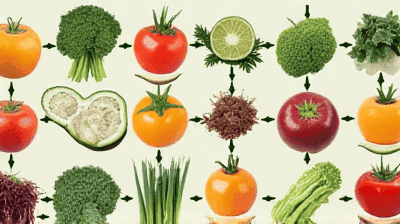
The global food system is in a state of crisis. With over 800 million people facing hunger and nearly one-third of all food produced going to waste, there is an urgent need for a transformative approach to food production, distribution, and consumption. The circular food economy offers a promising solution by rethinking how we produce and consume food. This model focuses on minimizing waste, maximizing resource efficiency, and creating a sustainable food system that benefits both people and the planet.
The circular food economy reimagines the traditional linear food system, characterized by a "take-make-dispose" model, into a closed-loop system that prioritizes resource regeneration, waste reduction, and sustainability. In a circular food economy, resources are reused, repurposed, or recycled to create a more resilient and sustainable food system.
Key principles of the circular food economy include:
Design for Longevity: Products and systems are designed to last longer, minimizing the need for new inputs and reducing waste.
Resource Efficiency: Maximizing the use of resources, including materials, energy, and labor, to minimize waste and environmental impact.
Regenerative Practices: Implementing agricultural practices that restore soil health, enhance biodiversity, and capture carbon, contributing to ecosystem resilience.
Waste as a Resource: Viewing food waste and byproducts as valuable resources that can be transformed into new products, such as compost or energy.
Collaboration and Innovation: Fostering collaboration among stakeholders, including farmers, businesses, consumers, and policymakers, to promote innovation and systemic change.
The current linear food system is unsustainable, leading to significant environmental and social challenges:
Food Waste: Approximately 1.3 billion tons of food are wasted globally each year, contributing to greenhouse gas emissions and placing unnecessary pressure on natural resources.
Resource Depletion: Traditional agricultural practices often deplete soil health, water resources, and biodiversity, leading to diminishing returns and environmental degradation.
Climate Change: The food sector is responsible for approximately 30% of global greenhouse gas emissions, primarily due to land use, deforestation, and waste.
Food Insecurity: The disparity between food production and access persists, with millions going hungry while others waste food.
Developing a circular food economy addresses these challenges by promoting sustainable practices and equitable food access.

Sustainable agriculture practices form the foundation of a circular food economy. These practices emphasize soil health, biodiversity, and ecosystem services. Effective strategies include:
Crop Rotation and Diversity: Rotating crops and diversifying plant species enhances soil fertility, reduces pests and diseases, and boosts resilience to climate impacts.
Agroecology: Implementing agroecological principles combines traditional knowledge and modern science to create farming systems that are productive, resilient, and sustainable.
Organic Farming: Organic farming avoids synthetic fertilizers and pesticides, promoting healthier soils and ecosystems.
Regenerative Agriculture: This approach focuses on restoring soil health, increasing biodiversity, and capturing carbon through practices such as no-till farming, cover cropping, and agroforestry.
Minimizing food waste is a central tenet of the circular food economy. Key strategies for reducing waste include:
Educating Consumers: Raising awareness about food waste, proper food storage techniques, and meal planning can empower consumers to make informed choices.
Improving Supply Chain Efficiency: Identifying inefficiencies in the food supply chain can help reduce losses at various stages, from production to retail.
Implementing Technology Solutions: Innovations such as inventory management systems, food tracking apps, and predictive analytics can aid in reducing waste across the supply chain.
Food Recovery Programs: Implementing food recovery initiatives that connect surplus food with those in need can redistribute resources and minimize waste.
Designing circular supply chains involves creating systems that prioritize sustainability, collaboration, and transparency. Components include:
Integration of Byproducts: Identifying opportunities to use agricultural byproducts, such as converting crop residues into animal feed, energy, or compost.
Collaboration with Local Producers: Partnering with local farmers and suppliers can reduce transportation emissions and support regional economies.
Traceability and Transparency: Implementing traceability systems throughout the supply chain ensures transparency and accountability, allowing consumers to make informed choices.
Local food systems are pivotal in building a circular food economy. Benefits include:
Supporting Local Economies: Purchasing food from local producers strengthens regional economies and fosters community resilience.
Enhancing Food Security: Local food production can address food deserts by increasing access to fresh, nutritious food.
Community Education: Engaging communities in food education programs can promote sustainable practices and build awareness around food consumption.
Innovation plays a crucial role in transitioning to a circular food economy. Emerging technologies can offer solutions to various challenges, such as:
Smart Agriculture: Using sensors, IoT devices, and data analytics can optimize resource use and improve farming practices.
Biotechnology: Innovations in biotechnology can lead to the development of crops that are more resilient to climate change, pests, and diseases.
Food Waste Upcycling: Companies are exploring ways to upcycle food waste into high-value products, such as snacks, animal feed, and ingredients.
Reduced Greenhouse Gas Emissions: By minimizing food waste and implementing sustainable agricultural practices, the circular food economy can significantly lower greenhouse gas emissions associated with food production and disposal.
Improved Soil Health: Regenerative practices promote healthy soils, enhancing water retention, nutrient cycling, and biodiversity.
Conservation of Resources: A circular system focuses on resource efficiency, reducing the need for synthetic inputs and conserving water and land.
Biodiversity Preservation: By supporting diverse cropping systems and local food production, the circular food economy helps conserve biodiversity and ecosystem health.
Cost Savings: Reducing waste and optimizing resource use can lead to significant cost savings for consumers, producers, and businesses.
Job Creation: Transitioning to a circular food economy can create new jobs in sustainable agriculture, food recovery, and resource management.
Enhanced Resilience: Local food systems are often more resilient to global market fluctuations and supply chain disruptions, providing stability for communities.
Food Security: Reducing food waste and enhancing local food systems can improve access to fresh and nutritious food for marginalized communities.
Healthier Communities: Increased access to nutritious food contributes to improved public health outcomes, reducing healthcare costs associated with diet-related diseases.
Community Empowerment: Engaging communities in sustainable practices fosters a sense of ownership and agency over food systems, empowering individuals and groups to effect change.

Transitioning to a circular food economy requires overcoming existing structural barriers, including:
Policy Frameworks: Many current agricultural and trade policies incentivize linear practices, making it difficult to adopt circular approaches.
Financial Barriers: Access to capital for small-scale farmers and food businesses can be limited, hindering investment in sustainable practices.
Changing consumer habits can be challenging, as entrenched behaviors and preferences influence purchasing decisions. Strategies for addressing this challenge include:
Education and Awareness Campaigns: Promoting awareness of the benefits of the circular food economy can encourage consumers to make more sustainable choices.
Promoting Sustainable Alternatives: Creating and marketing products that embody circular principles can offer consumers viable options for sustainable consumption.
Though technology can facilitate the transition to a circular food economy, challenges remain, such as:
Access to Technology: Small farmers and food producers may lack access to advanced technologies that optimize production and reduce waste.
Integration Issues: Implementing new technologies into existing systems can present challenges related to compatibility, training, and infrastructure.
Conducting an assessment of current food production and consumption practices is essential for identifying areas of improvement and opportunities for waste reduction.
Involve a diverse group of stakeholders, including farmers, businesses, consumers, and policymakers, to ensure their voices are heard in designing a circular food economy.
Create concrete action plans that outline the goals, strategies, and steps needed to transition to a circular food economy. These plans should include measurable milestones to track progress.
Implement educational initiatives to educate farmers, businesses, and consumers about sustainable practices, food waste reduction, and circular economy principles.
Encourage collaboration between various stakeholders to create synergies, share best practices, and promote innovation in food systems.
Continuously monitor and evaluate the outcomes of circular initiatives, using data to inform decision-making and adapt strategies as needed.

The Ellen MacArthur Foundation has played a pivotal role in promoting circular economy principles across various sectors, including food. The foundation’s initiatives encourage collaboration between businesses, governments, and communities to develop innovative solutions that promote resource efficiency and sustainability.
Several restaurants around the world are adopting zero-waste principles, minimizing food waste through creative culinary practices, composting, and sourcing from local producers. These establishments demonstrate that waste reduction can be both economically viable and environmentally responsible.
CSAs establish a direct relationship between farmers and consumers, encouraging local food production while promoting sustainable practices. By providing consumers with seasonal produce, CSAs reduce food waste and support local economies.
Waste-to-energy initiatives transform organic waste into renewable energy, creating a closed-loop system that contributes to resource efficiency and waste reduction. Facilities that convert food waste into biogas help power local communities while minimizing landfill contributions.
The transition to a circular food economy represents a significant opportunity to reimagine our food systems for a sustainable future. As awareness of environmental challenges continues to grow, collaboration among stakeholders will be essential in driving systemic change.
Innovative approaches will be key to overcoming current challenges and enhancing circularity in food systems. Advancements in biotechnology, sustainable farming practices, and technology-driven solutions will play a crucial role in shaping a more resilient and waste-free food economy.
Supportive policies and frameworks are essential for enabling the circular food economy. Governments can incentivize sustainable practices, establish regulations that promote waste reduction, and provide funding for initiatives that align with circular principles.
Consumers play a crucial role in driving change within the food system. By making informed choices, advocating for sustainable practices, and supporting local food producers, consumers can contribute to the success of the circular food economy.
The circular food economy presents a transformative opportunity to design a waste-free food system that promotes sustainability, resilience, and equity. By embracing principles of resource efficiency, collaboration, and innovation, we can create a food system that nourishes people while conserving the planet's resources. Transitioning to a circular food economy requires collective effort and commitment from all stakeholders, including farmers, businesses, consumers, and policymakers. Together, we can build a sustainable future where food waste is minimized, resources are conserved, and all individuals have access to nutritious food.